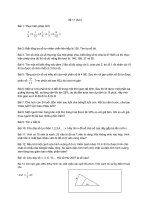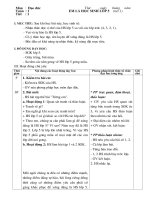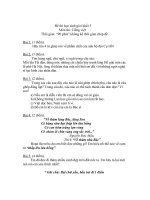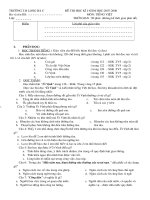5 2 his name was amerigo
Bạn đang xem bản rút gọn của tài liệu. Xem và tải ngay bản đầy đủ của tài liệu tại đây (3.61 MB, 10 trang )
His Name Was
Fascinating Facts
AMERIGO
• Amerigo Vespucci’s cousin, Simonetta Vespucci, was
known for her beauty. The famous painting by Sandro
Botticelli called The Birth of Venus, painted about 1485,
may be a portrait of her.
• The name America was originally just given to the
southern continent. It was only years later that the
northern continent came to be known as North America.
• In Latin, Amerigo is Americus. The male name Americus was
changed to the female name America to match the female
names of the other continents. The Latin names of the
other continents are Europa, Africa, and Asia.
Genre
Nonfiction
Comprehension Skill
Sequence
Text Features
• Maps
• Sidebars
• Captions
Scott Foresman Social Studies
ISBN 0-328-14888-1
ì<(sk$m)=bei ic< +^-Ä-U-Ä-U
by Ellen B. Cutler
His Name Was
Who was Amerigo Vespucci and why was America
named for him? In this book you will read about this
Italian explorer and the challenges he faced on the seas.
AMERIGO
Write to It!
Do you think the new continents should have been
named after Amerigo Vespucci or Christopher
Columbus? Write a paragraph to persuade people
that America should have been named “Columbia”
or that “America” is the best name for the continents.
Vocabulary
astronomy
maritime
expedition
embark
Write your paragraph on a separate sheet
of paper.
latitude
longitude
astrolabe
cartographer
Maps
MapQuest, Inc.
Photographs
by Ellen B. Cutler
Every effort has been made to secure permission and provide appropriate credit for photographic material. The publisher deeply
regrets any omission and pledges to correct errors called to its attention in subsequent editions.
ISBN: 0-328-14888-1
Unless otherwise acknowledged, all photographs are the property of Scott Foresman, a division of Pearson Education.
Photo locators denoted as follows: Top (T), Center (C), Bottom (B), Left (L), Right (R) Background (Bkgd)
Copyright © Pearson Education, Inc.
All Rights Reserved. Printed in the United States of America. This publication is protected
by Copyright, and permission should be obtained from the publisher prior to any prohibited
reproduction, storage in a retrieval system, or transmission in any form by any means,
electronic, mechanical, photocopying, recording, or likewise. For information regarding
permission(s), write to: Permissions Department, Scott Foresman, 1900 East Lake Avenue,
Glenview, Illinois 60025.
1 2 3 4 5 6 7 8 9 10 V0G1 14 13 12 11 10 09 08 07 06 05
Opener: (C) ©The Granger Collection, NY, (Inset) ©Brand X Pictures, (Bkgd) ©Brand X Pictures
2 ©Stefano Bianchetti/Corbis
3 ©Giraudon/Art Resource,
NY
Editorial
Offices: Glenview, Illinois • Parsippany, New Jersey • New York, New York
7 ©Getty Images
9 ©Adam Woolfitt/Corbis Sales Offices: Needham, Massachusetts • Duluth, Georgia • Glenview, Illinois
11 ©The Granger Collection,
NY
Coppell,
Texas • Sacramento, California • Mesa, Arizona
13 ©Sue Cunningham/Worldwide Picture Library/Alamy Images
14 ©Bildarchiv Preussischer Kulturbesitz/Art Resource, NY
Who was Amerigo Vespucci?
Amerigo Vespucci was born in Florence, Italy, on March
9, 1454. He came from a large and well-respected family.
Young Vespucci studied subjects such as geography, math, and
astronomy, or the scientific study of the stars and planets.
He learned to read and write in Latin. After finishing school he
went to work for the Medici (MEH-dih-chee) family.
The Medici quickly
recognized Vespucci’s
abilities. In 1491 Vespucci
was sent to Seville, Spain.
He joined a business that
provided ships with supplies
that might be needed on a
long sea voyage.
This engraving of
Amerigo Vespucci was
made in the 1800s.
Florence and the Renaissance
Vespucci lived during the Renaissance, a time of great
achievements. Scientists made important discoveries. Artists
painted pictures and made statues of marble and bronze for
churches, government buildings, and private homes.
The Medici were among the most powerful citizens in the
city, and they ruled Florence for nearly three hundred years.
The head of the family during the mid- to late-1400s was
known as Lorenzo the Magnificent, a merchant and a banker.
A Sense of Adventure
Spain was a great maritime
power with ships that traveled
from Spanish ports to cities in
Europe and northern Africa.
It was an exciting time that
sparked Vespucci’s sense of
adventure.
Christopher Columbus
made his first voyage across
the Atlantic Ocean in 1492.
Vespucci knew all about
Columbus’s voyages. Vespucci’s
company even stocked a ship for
Columbus’s second voyage, and
the two men became friends.
3
Vespucci helped supply the
ships Columbus (shown here)
used on his second voyage
across the Atlantic Ocean.
Vespucci’s Voyages
Vespucci was determined to join in the search for a sea
route to the Far East. He knew the supplies needed for such a
long sea voyage. Because he had studied astronomy, he could
plot a course by looking at the stars.
NORTH
AMERICA
EUROPE
PORTUGAL
The First Voyage
In May 1499 Vespucci got his wish. He was hired as the
navigator for an expedition and embarked on his first
voyage across the Atlantic Ocean. A navigator charts the
course of a ship. When he reached the coast of what is now
called South America, Vespucci continued south in search
of now a route to Asia. He sailed beyond the mouth of the
Amazon River before returning to Spain. Vespucci was back in
Spain by June 1500.
Vespucci turned back because his ship was in poor
condition. He was sure, however, that he had found the
passage to Asia and he was ready to try again.
ASIA
ATLANTIC
OCEAN
AFRICA
SOUTH
AMERICA
Vespucci’s
second voyage,
1501–1502
N
0
0
1,500
1,500
3,000 Miles
3,000 Kilometers
The Second Voyage
The European Discovery of America
Merchants brought spices and silk to Europe from India and
China. Traveling to Asia by land, however, was difficult. Wars
also made the trip even more dangerous.
Columbus thought he could reach the Far East by sailing
west across the Atlantic Ocean. He persuaded King Ferdinand
and Queen Isabella of Spain to support his plan. In 1492
Columbus believed he landed on an island in Asia called the
Indies. Therefore, he named the people there “Indians.”
4
The Spanish government was not interested in Vespucci’s
plans. He turned, therefore, to another maritime power,
Portugal. Vespucci embarked on his second voyage from the
city of Lisbon in May 1501.
Vespucci probably traveled along the east coast of South
America to the southern border of Brazil on this voyage. He
may have gone as far as southern Argentina. Vespucci’s route
back to Portugal is not known, but his ship anchored in Lisbon
in July 1502.
5
Vespucci’s Last Years
At the end of his life, Vespucci was one of the most famous
people in Europe. The letters he wrote describing his voyages
were copied into several languages and printed in books.
In 1505 Vespucci became a Spanish citizen. The Spanish
government gave him the job of piloto mayor or “master
navigator.” One of his duties was to prepare a map of the best
routes for ships to travel in order to reach what he called the
“New World.” Vespucci died in Seville, Spain, in 1512.
Two Voyages or Four?
Did Vespucci embark on two voyages or four? The records
are simply not clear.
The main source of information about his voyages are the
letters Vespucci wrote to friends and government officials. In
his later letters, Vespucci added details and changed some of
the dates. Vespucci claims in some letters that he went to the
the Americas four times. But only two voyages can be proved.
This image shows a copy of the signature of
Amerigo Vespucci, piloto mayor.
6
7
Following the Stars
Longitude
Navigation is the science of guiding a boat safely from one
place to another. A navigator must decide what direction to
go, how far the ship has traveled, and where it is on the open
sea.
Today there are instruments that show a ship’s latitude and
longitude. In Vespucci’s day navigators studied astronomy
and followed the stars. Clouds and storms could easily send
sailors off course.
It was harder to measure longitude than latitude. Ships often
had to take a zigzag course as they sailed to make the best
use of the wind. Changes in direction made it hard for sailors
to determine how far they had traveled.
Dead reckoning was the most common way to measure
longitude. In dead reckoning, the navigator followed changes
in direction with a compass. He tracked how many hours the
ship had been sailing and how fast it had been going. From
this information, he made a guess about the distance east or
west the ship had sailed.
Latitude
Sailors knew whether they were in the northern or southern
part of the ocean by the position of stars. By using an
astrolabe, an instrument used to measure the height of the
Sun during the day or a star at night, sailors could determine
the ship’s latitude. It was hard, however, to keep the astrolabe
pointed at the Sun or a star because most of the time the ship
was moving.
The astrolabe was
invented by the ancient
Greeks. It was first used
in Europe in the early
1100s.
8
9
Vespucci’s Contributions
Vespucci the Navigator
Vespucci used what he knew about geography, math, and
astronomy to navigate his voyages. He had hoped to explore
Asia by sailing west.
But at that time, no one knew how far west explorers
needed to sail in order to reach Asia. Columbus thought
he had reached the Far East in 1492. Vespucci thought he
had discovered a route to Asia during his first expedition.
However, this was not true.
Columbus had failed to reach the Far East. So had Vespucci.
Vespucci realized this during his second voyage. He compared
the land he had reached with what was already known about
Asia. It did not match.
Vespucci had reached a land that Europeans had never
before explored. It was a “New World” to them. Many believe
this to be Vespucci’s greatest discovery.
Vespucci is known for other reasons too. He mapped
thousands of miles of coastline that he explored. We know
today that this land is the continent of South America.
What Vespucci Learned
Knowing the distance between Italy and South America
showed Vespucci that he was still thousands of miles away
from the Indies. He realized that Columbus was wrong. This
land was not in Asia. It was a new land to the Europeans, a
“New World.”
10
Amerigo Vespucci was an Italian navigator who
sailed for Spain and Portugal.
11
The New World
Vespucci’s letters were full of interesting details about
what he had seen. He wrote that the people he had seen
were fast runners and excellent swimmers, and that their
skin was almost red, “like a lion’s mane.” The people built
huts from branches and palm leaves, and some of the
houses were large enough to hold “six hundred souls.”
The native people, Vespucci said, placed a high value
on things like feathers or “birds’ plumes of many colors.”
They made necklaces from fish bones and white or green
stones. According to Vespucci, they did not care, however,
about gold, jewels, and pearls.
Naming the New World
Amerigo Vespucci was not the first person from Europe
to sail across the Atlantic Ocean. He did not bring back
shiploads of gold and other things of value. The continents
that he called the New World, however, are named for
him.
The Brazilian Macaw is the
largest parrot in the world. It
can be found in the rain forests
of South America.
12
13
Naming America
The cartographer Martin Waldseemüller (WALD-saymule-er) suggested a name for the “New World” in 1507. A
cartographer is a mapmaker.
Waldseemüller was working on a new and more current
map of the world. For more than a thousand years, maps were
largely copies of the one
drawn by the ancient Greek
cartographer Ptolemy (TALLeh-mee) over a thousand
years before. Waldseemüller
wanted to make a new map
that was more complete and
up-to-date.
The map Waldseemüller
drew was the first one to
show the newly explored
lands across the Atlantic
Ocean. He also suggested
that this land be named
Americus or America.
Martin Waldseemüller’s map was so large it had to be printed on twelve
sheets of paper. At the top of the map are portraits of Ptolemy (left) and
Vespucci (right). Ptolemy stands next to a picture of his map of the world.
Vespucci stands next to a map showing the lands he helped explore. North
America looks like a large island. South America is long and thin. The name
America, which is printed on the southern continent, appears for the first time
on Waldseemüller’s map.
14
15
Who was Amerigo Vespucci and why was America
named for him? In this book you will read about this
Glossary
Italian explorer and the challenges he faced on the seas.
astrolabe an instrument used by navigators to
determine latitude
Write to It!
Do you think the new continents should have been
named after Amerigo Vespucci or Christopher
Columbus? Write a paragraph to persuade people
that America should have been named “Columbia”
or that “America” is the best name for the continents.
Vocabulary
astronomy the scientific
study of the stars, planets, and
astronomy
other bodies beyond Earth’s
atmosphere
maritime
cartographer a mapmaker
expedition
embark to set out on a venture
embark
expedition a journey made
for a special purpose
latitude
latitude the measurement of how far north or south of the
longitude
equator a place is located
Write your paragraph on a separate sheet
of paper.
astrolabe
longitude the measurement
of how far east or west of the
prime meridian (0° longitude)
a place is located
cartographer
maritime having to do with the sea or sailing
Maps
MapQuest, Inc.
Photographs
Every effort has been made to secure permission and provide appropriate credit for photographic material. The publisher deeply
regrets any omission and pledges to correct errors called to its attention in subsequent editions.
Unless otherwise acknowledged, all photographs are the property of Scott Foresman, a division of Pearson Education.
ISBN: 0-328-14888-1
Photo locators denoted as follows: Top (T), Center (C), Bottom (B), Left (L), Right (R) Background (Bkgd)
Copyright © Pearson Education, Inc.
All Rights Reserved. Printed in the United States of America. This publication is protected
by Copyright, and permission should be obtained from the publisher prior to any prohibited
reproduction, storage in a retrieval system, or transmission in any form by any means,
electronic, mechanical, photocopying, recording, or likewise. For information regarding
permission(s), write to: Permissions Department, Scott Foresman, 1900 East Lake Avenue,
Glenview, Illinois 60025.
16
1 2 3 4 5 6 7 8 9 10 V0G1 14 13 12 11 10 09 08 07 06 05
Opener: (C) ©The Granger Collection, NY, (Inset) ©Brand X Pictures, (Bkgd) ©Brand X Pictures
2 ©Stefano Bianchetti/Corbis
3 ©Giraudon/Art Resource, NY
7 ©Getty Images
9 ©Adam Woolfitt/Corbis
11 ©The Granger Collection, NY
13 ©Sue Cunningham/Worldwide Picture Library/Alamy Images
14 ©Bildarchiv Preussischer Kulturbesitz/Art Resource, NY






![Ke chuyen Lop 5[2].ppt](https://media.store123doc.com/images/document/13/pt/ev/medium_evu1372525566.jpg)


